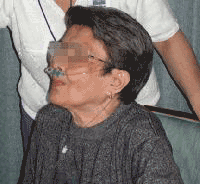


abbreviations and reference ranges.
a, arterial; CO2, carbon dioxide; P, partial pressure (used of a gas in fluids); O2, oxygen; S, saturation (%). Blood Hb: adult male 140-170 g/l, adult female 120-155 g/l. PaO2: varies with age etc. Normally about 13 kPa (100 mmHg).
Mr Blue and Mrs Pink are seen on the same night at an emergency clinic. Both
are 65 and both have respiratory difficulties.
Both patients complain of severe asthma and are treated with nebulised bronchodilator
by inhalation. Both have had symptoms for about ten years and are markedly
restricted in their daily activities by breathlessness. However, both have
had increased cough and symptoms in the last week. Mr Blue has been 'unable
to sleep for the last four nights' in spite of four-hourly nebulised bronchodilator
and has clear sputum. Mrs Pink has a dry cough, her breathlessness is worse
than usual and she feels that her general health is going downhill.
* what do you think is going on here--are these presentations consistent with asthma? Is a patient's formulation of their illness reliable?
Mr Blue has an arterial hemoglobin (Hb) saturation (Sa02) by fingertip pulse
oximetry of 90% and Mrs Pink of 95%.
* the pulse oximeter uses the relative absorbance of two wavelengths of light
by arterial blood to estimate Sa02. What value is expected in health? Why
is Mr Blue's 'saturation' reduced, and what would be the effects of this?
How would the interpretation of Sa02 be affected by anemia? By carbon monoxide
exposure (smoker) or poisoning?
On examination Mr Blue is mildly centrally cyanosed while Mrs Pink is pink,
but has a marked increase in resting respiratory rate and appears anxious.
There is no chest dullness on percussion or fever to suggest chest infection.
* what is 'cyanosis' and what is it due to? What might cause cyanosis in
the hands and feet (acrocyanosis, peripheral cyanosis)? In the lips and
face ('central' cyanosis)? What does the presence of cyanosis imply about
the level of hemoglobin?
Mr Blue complains of exhaustion with coughing and is sent to a hospital.
Mrs Pink asks about a prescription for a mild relaxant (diazepam, a benzodiazepine)
to ease her state.
* can you suggest a reason why Mrs Pink is so troubled by dyspnea when her
oxyhemoglobin saturation is reasonable? Can you suggest why Mr Blue is
not troubled by this in spite of a clearly reduced Sa02? Is there any reason
not to help Mrs Pink as she requests by prescribing her a mild tranquilliser?
Sources of further information (links valid May 2004-please report broken links):
The Merck Manual's page on COPD. As usual,
this book surveys the topic quickly and clearly.
Poole PJ, Bagg B, Brodie SM, Black PN: Characteristics of patients admitted to hospital with chronic obstructive pulmonary disease. NZMJ. 1997 Jul 25;110(1048):272-5. Abstract available here. This article, by one of your lecturers in this course, gives a local perspective on the condition by describing Auckland patients with COPD.
Huib A M Kerstjens: Stable chronic obstructive pulmonary disease. BMJ 1999;319:495-500
. What, if any, treatment is effective in COPD?